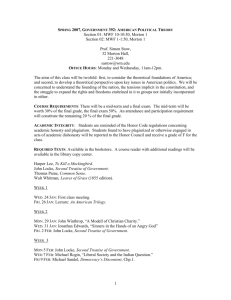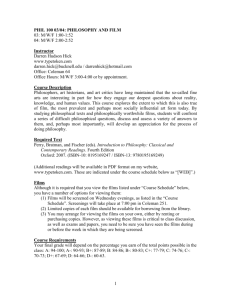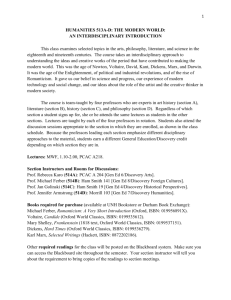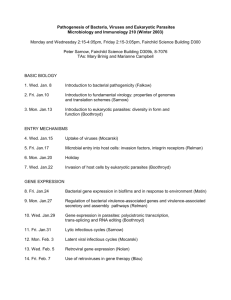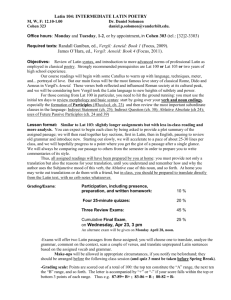ME:5159 FRACTURE MECHANICS Spring 2016
advertisement
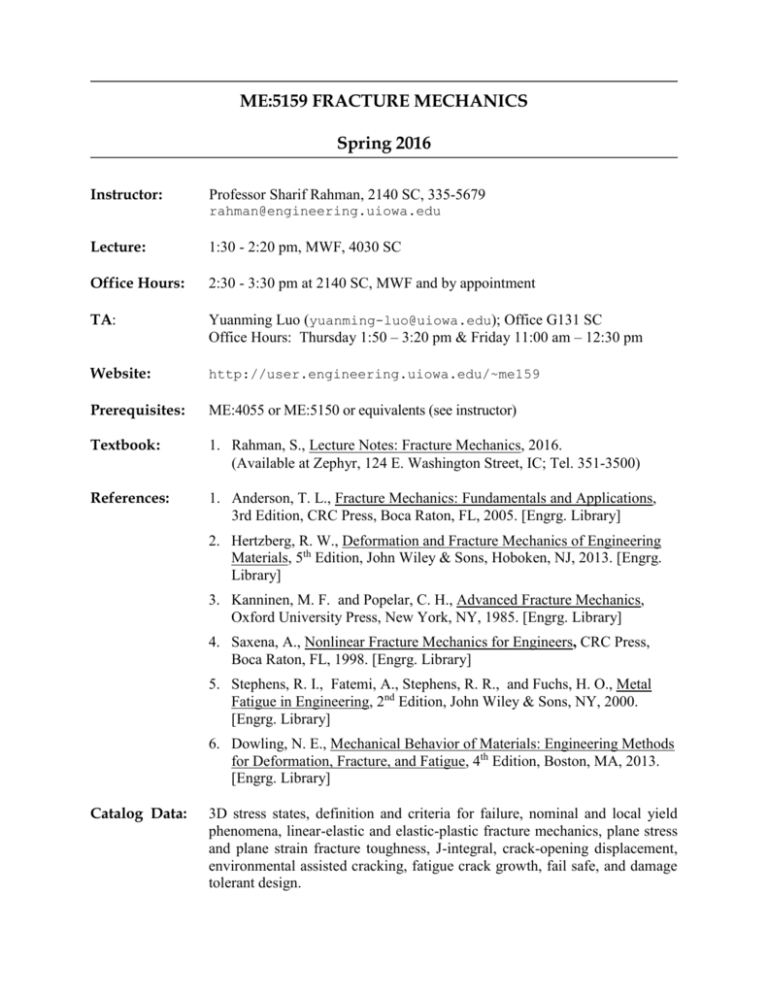
ME:5159 FRACTURE MECHANICS Spring 2016 Instructor: Professor Sharif Rahman, 2140 SC, 335-5679 rahman@engineering.uiowa.edu Lecture: 1:30 - 2:20 pm, MWF, 4030 SC Office Hours: 2:30 - 3:30 pm at 2140 SC, MWF and by appointment TA: Yuanming Luo (yuanming-luo@uiowa.edu); Office G131 SC Office Hours: Thursday 1:50 – 3:20 pm & Friday 11:00 am – 12:30 pm Website: http://user.engineering.uiowa.edu/~me159 Prerequisites: ME:4055 or ME:5150 or equivalents (see instructor) Textbook: 1. Rahman, S., Lecture Notes: Fracture Mechanics, 2016. (Available at Zephyr, 124 E. Washington Street, IC; Tel. 351-3500) References: 1. Anderson, T. L., Fracture Mechanics: Fundamentals and Applications, 3rd Edition, CRC Press, Boca Raton, FL, 2005. [Engrg. Library] 2. Hertzberg, R. W., Deformation and Fracture Mechanics of Engineering Materials, 5th Edition, John Wiley & Sons, Hoboken, NJ, 2013. [Engrg. Library] 3. Kanninen, M. F. and Popelar, C. H., Advanced Fracture Mechanics, Oxford University Press, New York, NY, 1985. [Engrg. Library] 4. Saxena, A., Nonlinear Fracture Mechanics for Engineers, CRC Press, Boca Raton, FL, 1998. [Engrg. Library] 5. Stephens, R. I., Fatemi, A., Stephens, R. R., and Fuchs, H. O., Metal Fatigue in Engineering, 2nd Edition, John Wiley & Sons, NY, 2000. [Engrg. Library] 6. Dowling, N. E., Mechanical Behavior of Materials: Engineering Methods for Deformation, Fracture, and Fatigue, 4th Edition, Boston, MA, 2013. [Engrg. Library] Catalog Data: 3D stress states, definition and criteria for failure, nominal and local yield phenomena, linear-elastic and elastic-plastic fracture mechanics, plane stress and plane strain fracture toughness, J-integral, crack-opening displacement, environmental assisted cracking, fatigue crack growth, fail safe, and damage tolerant design. Course Objectives 1. Students will have the knowledge of 2D and 3D field equations of elasticity, material yield criteria, stress concentrations, and introduction to the finite element method. 2. Students will have a fundamental understanding of linear-elastic fracture and will able to solve elementary linear-elastic fracture-related problems. 3. Students will be able to analyze stationary cracks and perform crack propagation in 2D linearelastic mechanical components of arbitrary geometry using commercially available finite element software. 4. Students will have an understanding of crack-tip plasticity and elastic-plastic fracture and will able to solve practical elastic-plastic fracture problems using J-estimation methods. 5. Students will be able to analyze planar cracks in 3D elastic-plastic mechanical components using commercially available finite element software. 6. Students will have an elementary knowledge of fatigue crack growth and will be able to conduct fatigue life prediction of simple mechanical components under constant-amplitude loading. 2 Course Outline (44 Meetings) 1 Introduction 1. Relevance, Motivation, and Examples 2 Review of Elasticity Theory, Stress Concentration, and FEM 2. 3D Elasticity Equations in the Cartesian System 3. 2D Elasticity Equations in the Polar System and Yield Criteria 4. Stress Concentration in Mechanical Components 5. Formulation of 2D Finite Element Analysis 6. Introduction to CASCA/FRANC2D and Computer Project No. 1 7. Computer Project No. 1 (Contd.) 8. Computer Project No. 1 (Contd.) 3 Linear-Elastic Fracture Mechanics (LEFM) 9. Stress-Intensity Factors (SIFs), Crack-Tip Fields, and Energy Release Rate 10. SIFs for Common Fracture Specimens 11. Singular Finite Elements 12. Computational Methods for Evaluating SIFs 13. Fracture Toughness, SIF as a Failure Criterion, and Examples 14. 2D Fracture Analysis by CASCA/FRANC2D and Computer Project No. 2 15. Computer Project No. 2 (Contd.) 16. Computer Project No. 2 (Contd.) 17. Principle of Superposition in LEFM 18. Fracture Analysis of Fuselage Lap Joints: Aircraft Industry 19. Mixed-Mode Fracture Analysis and Crack Trajectory Prediction 20. 2D Crack Propagation by CASCA/FRANC2D and Computer Project No. 3 21. Computer Project No. 3 (Contd.) 4 Elastic-Plastic Fracture Mechanics (EPFM) 22. Crack-Front Process Zone and Limitations of LEFM 23. The J-integral, HRR Singularity Fields, and Validity of J 24. Pipe Fracture Evaluations by the GE/EPRI Method 25. Fracture Analysis of Ductile Piping: Nuclear Industry 26. Pipe Fracture Evaluations by Limit-Load Analysis 27. 3D Fracture Analysis by ABAQUS/CAE and Computer Project No. 4 28. Computer Project No. 4 (Contd.) 29. Computer Project No. 4 (Contd.) 30. Computer Project No. 4 (Contd.) 31. Crack-Opening-Area (COA) Analysis by the GE/EPRI Method 32. Leak-Rate Analysis and NRC Leak-Before-Break Concept 33. An Example on Leak-Before-Break Analysis 5 Fatigue Crack Propagation 34. Subcritical Crack Propagation and Various Crack-Growth Equations 35. Life Prediction under Constant Amplitude Loading 36. Crack Closure, Variable Amplitude Loading, and Crack-Tip Plasticity 37. Life Prediction by CASCA/FRANC2D and Computer Project No. 5 38. Computer Project No. 5 (Contd.) 39. Computer Project No. 5 (Contd.) + [1 class for video on experimental fracture] + [2 classes for examinations] + [2 classes for reviews] 3 Performance Evaluation Criteria A. Homework and Project Assignments The assigned homework problems and computer projects should be worked out and submitted to the instructor in a professional format at the beginning of the lecture period. Include your name, course title, assigned homework/project problem numbers in the heading of your paper. The dates of assignments and their due dates are given in the attached assignment sheet (Page 5). Your homework/project solution must be submitted individually. No group submission or copies are permitted. If a copy is detected, a zero score will be assigned to all papers in question. You are advised to obtain help from the instructor or the TA. Unless appropriate reason(s) is (are) given, late submission will not be accepted. B. Examination Policy There will be two examinations (Examinations 1 and 2) in this course. Both will be closed-book examinations. The tentative schedules for the examinations are: Examination 1: 1:30-2:20 pm, March 11, 2016, Fri at 4030 SC Examination 2: 1:30-2:20 pm, May 06, 2016, Fri at 4030 SC (The exact date/time/place will be confirmed or revised during the semester) If any of these examinations is missed, the instructor will use his discretion in choosing alternative means to evaluate student's performance. This can be a make-up examination, oral examination, or both. C. Grading Policy A student must turn in all HW/CP solutions to receive a passing grade. The letter grade for this course will be based on the student’s overall performance on homework assignments and computer projects; midterm; and final examinations. The distribution of points is as follows: 1. 2. 3. 4. Homework Assignments Computer Projects Examination 1 Examination 2 25 percent 25 percent 25 percent 25 percent The final grade will be posted on the web at the end of the semester. 4 Assignment Sheet for ME:5159 Fracture Mechanics (Spring 2016) Wk. 1 2 3 4 5 6 7 8 9 10 11 12 13 14 15 16 Mtg. (Lec.) 1 (1) 2 (2) 3 (3) 4 (4) 5 (5) 6 (6) 7 (7) 8 (8) 9 (9) 10 (10) 11 (11) 12 (12) 13 (13) 14 (14) 15 (15) 16 (16) 17 (17) 18 (18) 19 (19) 20 (20) 21 (21) 22 23 Date Jan 20, Wed Jan 22, Fri Jan 25, Mon Jan 27, Wed Jan 29, Fri Feb 01, Mon Feb 03, Wed Feb 05, Fri Feb 08, Mon Feb 10, Wed Feb 12, Fri Feb 15, Mon Feb 17, Wed Feb 19, Fri Feb 22, Mon Feb 24, Wed Feb 26, Fri Feb 29, Mon Mar 02, Wed Mar 04, Fri Mar 07, Mon Mar 09, Wed Mar 11, Fri 24 (22) 25 (23) 26 (24) 27 (25) 28 (26) 29 (27) 30 (28) 31 (29) 32 (30) 33 (31) 34 (32) 35 (33) 36 (34) 37 (35) 38 (36) 39 (37) 40 (38) 41 (39) 42 (40) 43 44 Mar 21, Mon Mar 23, Wed Mar 25, Fri Mar 28, Mon Mar 30, Wed Apr 01, Fri Apr 04, Mon Apr 06, Wed Apr 08, Fri Apr 11, Mon Apr 13, Wed Apr 15, Fri Apr 18, Mon Apr 20, Wed Apr 22, Fri Apr 25, Mon Apr 27, Wed Apr 29, Fri May 02, Mon May 04, Wed May 06, Fri Topics/Reading(a) Introduction (1-12) Review of Elasticity Theory (88-91) Review of Elasticity/Yield Criteria Stress Concentration FEM – 2D Elasticity Problems (554-556) CP1 – Stress Concentration (27-28) CP1 CP1/HW1 Stress Analysis of Cracks (42-48, 72-75) SIFs for Fracture Specimens (48-53) Singular Finite Elements (587-591) Numerical Evaluation of SIFs (558-586) SIF as a Failure Criterion (58-61, 69-79) CP2 – 2D Mode-I Fracture Analysis CP2 CP2/HW2 Principle of Superposition (54-57) Applications – Aircraft Industry Mixed-mode Fracture (80-85) CP3 – 2D Mixed-Mode Fracture Analysis CP3/HW3 Review Examination 1 Spring Break (Mar 14-18) Fracture Process Zone (61-71) EPFM, J-integral, HRR (103-133) Pipe Fracture Evaluation Applications – Nuclear Industry (398-401) Limit-Load Analysis/HW4 CP4 – 3D Pipe Crack Analysis CP4 CP4 CP4/HW5 Crack-Opening-Area Analysis Crack-Opening/NRC LBB Design Example based NRC LBB Fatigue Crack Propagation (451-457) Fatigue Life Prediction (451-459) Crack Closure, etc./HW6 (457-459) CP5 – Fatigue Crack Growth Analysis CP5 CP5 Experimental Fracture (Video) Review Examination 2 HW/CP Due Date HW1 Feb 08, Mon CP1 Feb 15, Mon HW2 Feb 26, Fri CP2 Mar 04, Fri HW3 Mar 09, Wed CP3 Mar 23, Wed HW4 Apr 01, Fri CP4 Apr 11, Mon HW5 Apr 18, Mon HW6 Apr 25, Mon CP5 May 02, Mon (a) Parenthetical values are page nos. of the Anderson book; HW = homework; CP = computer project 5 Regulations Dealing with Academic Misconduct August 1980 The College of Engineering endorses the policies and rights of students as printed in the "Policies and Regulations Affecting Students" of The University of Iowa. Under Section 1 in the Code of Student Life, which appears in the above publication and has been adopted by the College of Engineering Faculty, the College has the authority to handle acts of academic misconduct, which are defined in Section 1 as: “Academic dishonesty, including the acquisition of honors, awards, certification or professional endorsements, degrees, academic credits, or grades by means of cheating, plagiarism, or falsification with respect to any examination, paper, project, application, recommendation, transcript, or test, or by any other dishonest means whatsoever, or aiding or abetting another student to do so.” The following regulations provide a procedure for dealing with students who are alleged to have committed an act of academic misconduct: 1. Guidelines for Disciplinary Action by an Instructor Exams: In cases of cheating on hourly or final exams, it is recommended that the instructor reduce the student’s grade, including the assignment of the grade of “F” in the course. When a course grade has been reduced to an “F”, the student may not drop the course, nor use the Second Grade Option procedure to eliminate the failing grade from semester and cumulative GPA values that appear on the permanent record card (i.e., the grade transcript.) It is recommended that cheating on quizzes be considered as serious a violation as on exams and that the penalty be similar. The instructor shall send a written report of any disciplinary action to the Office of the Dean and the report shall be placed in the student’s file. Homework, Lab Reports, etc.: Each instructor shall announce at the beginning of each course the acceptable policies on student collaboration in each of the graded course requirements. When the policy is clearly violated, a zero shall be assigned for the total portion of the course grade allocated to the requirement in which the violation occurred (e.g., a zero for all homework assignments if cheating occurred on a homework assignment.) A written report of this action shall be sent by the instructor to the Office of the Dean and placed in the student’s file. 2. Student Appeal When a written report of disciplinary action by an instructor is received by the Office of the Dean, the student shall be notified in writing of the action. If the student feels that the finding of cheating is in error or the penalty is unjust, the student may request a hearing by notifying in writing the associate dean of the College, who will in turn appoint a committee to review the incident. If the student is not satisfied with the results of the hearing, the student may request a review by the Office of the Vice President for Academic Affairs. 3. Disciplinary Action by the Dean In cases of flagrant or a second offense, the dean of the College may impose the following or other penalties as the offense may warrant: cancellation of the student’s registration, disciplinary probation, suspension from the College, or recommendation of expulsion from the University by the President. If the student feels that the penalty imposed by the dean is unjust, the student may request a review by the Office of the Vice President for Academic Affairs. 4. Record of Disciplinary Action Reports of academic misconduct received by the Office of the Dean shall be placed in the involved student’s file maintained in the Office of the Dean. The Office of the Dean shall notify the student of each report and the right of the student to request a hearing for review of the case. The reports shall be destroyed when the student graduates or within two years after the student leaves the University. (These regulations are based on the recommendations of the Ad-Hoc Committee on Student Academic Conduct which were approved by the Faculty on April 29, 1980.) 6



